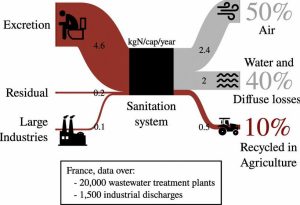L’année 2023 se termine avec, au pied du sapin, une publication de Thomas Starck, Tanguy Fardet et Fabien Esculier sur le devenir de l’azote dans le système d’assainissement en France. Le titre de l’article, publié dans la revue internationale Science of the total environment, peut être traduit par : « Devenir de l’azote issu des excrétats humains en France : des pertes actuelles aux opportunités agricoles futures »
Le résultat principal peut être résumé par la figure ci-dessous : seul 10% de l’azote excrété par les français est aujourd’hui recyclé en agriculture, via les boues de stations d’épuration.

Starck, T., Fardet, T., Esculier, F., 2024. Fate of nitrogen in French human excreta: Current waste and agronomic opportunities for the future, Science of The Total Environment, 912:168978.
Résumé
Nitrogen (N) is essential for plant growth and protein synthesis but global reactive N losses, mainly from food systems, induce strong environmental impacts. N losses after human excretion are often overlooked because, in Western societies, they partly occur as inert N2, following denitrification in wastewater treatment plants (WWTP), and losses in waters are often small compared to diffuse agricultural emissions. Yet N from human excretions could be used for crop fertilization, potentially with very high recycling rates via source separation. In this study we use unique operational data from the 20,000 French WWTPs to produce a N mass-balance of excretions in the French sanitation system. Even though 75 % of WWTPs’ sludge is spread on crops, only 10 % of the excreted N is recycled and 50 % of N is lost to the atmosphere, mainly through WWTP nitrification-denitrification. The remaining 40 % ends up in water or in diffuse losses in the ground, of which about half is lost outside of the WWTPs’ discharge system, through sewers storm water and individual autonomous systems. While WWTPs removal efficiency increased in the 2000s, it has been followed by a decade of stagnation, reaching 70 % at the national level. This national average hides regional discrepancies, from 60 to 85 % in the 6 French water agencies basins. These differences closely correlate with the classification as “N sensitive areas” and is mainly due to large WWTPs which handle most of the N load. Recycling all N in excretions could supply 10 % of domestic protein consumption in the current French food system, and up to 30 % if it is prioritized towards crop production for human consumption. Redesigning the food system (decrease of nutrient losses, more plant-based diets) could further increase this contribution.
